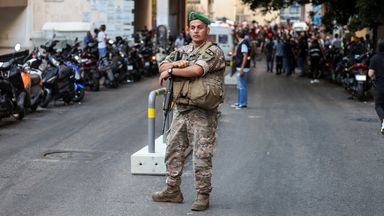Exploding pagers: How Israel is suspected of using technology against its enemies
A wave of deadly explosions across Lebanon and parts of Syria has targeted Hezbollah officials whose handheld pagers have blown up. One bomb expert suggests high explosives could have been planted into pagers.

Israel is accused of carrying out an audacious, high-tech and targeted attack on Hezbollah.
The unprecedented mass explosion of handheld pagers used by Hezbollah fighters came after the military group switched from mobile phones as a means of communication to reduce the risk of being tracked by Israel.
No one has claimed responsibility but Lebanese officials have accused Israel, which has not commented on the blasts.
There is a long history of Israel being accused of using inventive methods to eliminate its enemies.
Pager explosions: Middle East latest
How pagers could be deployed as bombs
A security expert, speaking on condition of anonymity, told Sky News someone could have tampered with these devices before they were distributed – such as by hiding explosives inside them that could be detonated remotely when a certain signal is sent to the pager.
Pagers pre-date mobile phones and are now uncommon in most Western countries, but were widely used in the 1980s and 1990s. They are a one-way communications device, allowing people to send a short message via radio signal to the pager. Often, in the past, it would have been a phone number inviting people to call back.
The source said the “general view I am hearing is that this was an impressive attack” which required a certain amount of co-ordination.
“It looks likely that the pagers they [Hezbollah] purchased may have been compromised and turned into remote bombs,” the security expert said, stressing that this was just speculation based on his expertise.
“[It] seems too coordinated and powerful an explosion to just be malfunction,” adding it was less likely to have been caused by the batteries overheating.
Injuries ‘consistent’ with high explosives
Bomb disposal expert and former British army officer Chris Hunter said: “We’ve seen this sort of similar MO [particular method] with mobile devices before.”
In 1996, Hamas master bomb maker Yahya Ayyash “was assassinated using a mobile phone with a small amount of explosives in it,” he said.
Mr Hunter says his initial theory – based on injuries – suggests the blasts are “consistent with 1 to 2 ounces of high explosive. And you could certainly get that amount in a pager.
“We’ve seen ETA [a separatist group operating in Spain], we’ve seen the Colombian groups, we’ve seen the provisional IRA use pagers as explosive devices,” he said.
Israel’s long history of high-tech warfare
Israel’s spy agencies have a long history of being linked to assassinations and covert activities using high-tech bombs and devices. Here is a summary of some of them:
1972: Bassam Abu Sharif
He was injured in Beirut when he opened a package containing a book implanted with a bomb which exploded. He was the spokesperson for the Popular Front for the Liberation of Palestine (PFLP).
He survived but lost several fingers, was left deaf in one ear and blind in one eye.
1972: Mahmoud Hamshari
A representative from the Palestine Liberation Organisation (PLO) was killed in Paris in 1972 when a bomb was planted under a telephone and remotely detonated.
1996: Yahya Ayyash
He earned the nickname “The Engineer” and apparently helped develop suicide bombs used in the Israeli-Palestinian conflict.
2000: Samih Malabi
A Fatah activist from the Kalandia refugee camp outside Ramallah, was killed when a booby-trapped mobile phone exploded next to his head.
2007: Stuxnet
A powerful computer worm designed by US and Israeli intelligence that is believed to have disabled a key part of the Iranian nuclear program.
Stuxnet was designed to destroy the centrifuges Iran used to enrich uranium as part of its weapons programme.
It is reported the worm was delivered to the facility on a thumb drive by an Iranian double agent working for Israel.
2020: Mohsen Fakhrizadeh
An Iranian nuclear scientist was assassinated in Iran by a remote-controlled machine gun mounted on a car.
Mr Fakhrizadeh was travelling in a bulletproof vehicle alongside three security personnel vehicles when he heard what sounded like bullets hitting his car.
After he reportedly left the vehicle, a Nissan fitted with a remote-controlled machine gun then opened fire killing him.



